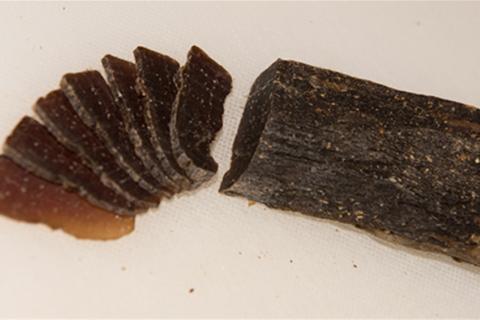
As much as we enjoy jerky here in the United States, biltong is doubly popular in its home country of South Africa, and around the world as South African expatriates have carried the flavorful dried meat around the globe.
This is How They Make Jerky in South Africa
Alas, Americans who have discovered a love for biltong when visiting the country are not allowed to bring it back into the United States due to restrictions on importing meat.
It is hard to describe what makes biltong so good, but a lot of it is the blend of tangy vinegar with spicy coriander. That and the form it takes. Unlike jerky, which is cut into thin strips before drying, biltong is typically dried in large, thick slices of muscle.
The South African treat is also dried under a lower heat then jerky, which is often dehydrated relatively quickly at a temperature of 150 degrees or above. By contrast, it takes days (or even weeks) to make biltong, which is hung at air temperature or just above.
Other than the extended drying times, biltong is not difficult to make, does not require any difficult-to-find ingredients or, also unlike jerky, no special curing agent. Instead, vinegar, along with a little bit of salt, is used as a means to prevent spoilage during the drying process.
While the following recipe will not satisfy every craving for biltong, it does come close. To get the real thing, made from game meats such as kudu or ostrich, I suggest a trip to South Africa.
Biltong Recipe Ingredients:
- 3 lbs venison sirloin
- ½ cup white or apple cider vinegar
- ½ cup ground coriander
- 2 tbs ground black pepper
- 2 tbs sea salt
- 2 tsp paprika
1. Cut the sirloin into strips 1½ inches wide by three-quarters on an inch thick. Place the sliced meat in a large bowl and pour the vinegar over the top. Mix the meat and vinegar around to ensure all the pieces are coated.
2. As the meat soaks in the vinegar, whisk the dry ingredients together well.
3. Lay the meat strips out on a cookie sheet or other flat surface and sprinkle the biltong seasoning over the meat. Flip the strips over and cover the second side. Do not skimp on the biltong seasoning. You want the meat well covered.
4. Hang the strips in a dry, well-ventilated area free from insects. You want the meat strips to get good airflow to aid the drying. Avoid humidity, which is the biggest cause of biltong spoilage. There are lots of plans on the Internet for make biltong boxes, but a large cardboard box fitted with a small fan works great. I use a Cabela's Commercial Grade Dehydrator set to its lowest temperature with the door propped open. Biltong can take anywhere from 3 days to a week or more, depending on the level of fat in the meat and the desired consistency.
5. To eat, slice crosswise into thin chip-like strips.
- 3352 views

